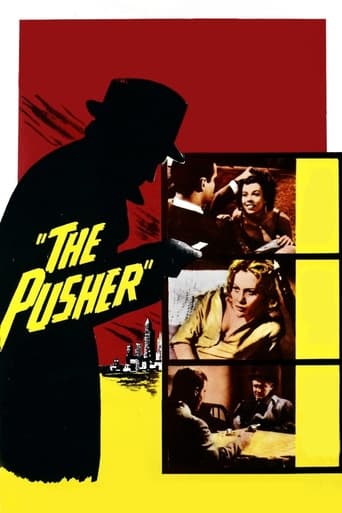

Another reviewer complained that this wonderful, moody and atmospheric film about heroin addiction was too "dreary.." I have to laugh at some of the comments I read here. New York City, circa 1958; a heroin kingpin sets up shop, and sets himself up in a posh penthouse apartment on Riverside Drive. His customers are mostly kids, many of them Puerto Rican immigrants looking to find their place in a new city, and they get hooked on the smack that Mario supplies them. Things start to get out of control when a Police Lieutenant's daughter gets hooked, while working at a shady nightclub in Midtown. The pusher himself, played by Felice Orlandi, is suitably sleazy and heartless, as he feeds off of the young people in the area, making himself rich while destroying their lives in the process. This film is remarkably realistic in it's depiction of both the business aspect and the addiction aspect of the drug culture. Beautifully filmed in shadowy, stark black and white, with New York City on display in all it's old time glory. Of course it's "dreary," and seedy, and downbeat. This title is very rare and i imagine a copy must be a real collectors item. It reminded me of the New York beat/jazz scene described in Kerouac's "On the Road," so much so, that I half expected William Burroughs to appear in one of those seedy Times Square bars shown in this film. This is a wonderful, lost movie that should be easier to find. Similar to "Hatful of Rain," another early 60's NYC heroin movie, although this one is better. "The Pusher" would make a great double feature with "Who Killed Teddy Bear," which is another 1960's study of the seedy underbelly of New York's times Square scene. A lost gem...
... View MoreThis film seemed to have some ready-made points in its favor, but alas almost all of them come to zilch. First of all, it's the only movie of any shape or form directed by ace Hollyweood film editor, Gene Milford. It's also the only film he produced. Secondly, it's one of only two movies in which Kathy Carlyle appeared. (She had a small role in a 1958 Charles Bronson "B" entitled "When Hell Broke Loose"). This time she's top billed. Thirdly, it's screenplayed by Harold "The Carpetbaggers" Robbins of all people from the 1956 novel by Ed McBain (Evan Hunter/Salvatore A. Lombino). Unfortunately, Mr Robbins does little justice to the novel. Milford's super-slow pacing and direction doesn't help either. Admittedly, he is hampered by a pretty charmless cast. And even Arthur Ornitz's photography seems weighed down by the general ineptitude.
... View MoreThis low-budget, independent picture's most significant point of interest is its writing pedigree -- it's based on a novel by hard-boiled favorite Ed McBain, with a screenplay by the best-selling novelist Harold Robbins. This contributes to a very schizophrenic result. The influence of the former is obvious in the police procedural framework, with some interesting shot-on-location scenes in Spanish Harlem and other NYC locales. The latter's heavy hand is apparent in the overblown melodramatic scenes which especially mar the last couple of reels.The story concerns a police detective who, while investigating the apparent suicide of a young Puerto Rican heroin addict, discovers that his middle-class daughter is involved in the same underworld. The parallels/contrasts between the white-bread girl and the poverty stricken ethnic types gives this exposé its main social significance -- presaging similar scenes in much more accomplished films like "Traffic". But of course, the good-girl-gone-bad scenario was a staple of old-time exploitation pix way back in the days of silent movies and Dwain Esper.Unfortunately, the filmmakers, though competent enough for the most part, really have no sense of style or tension, and the film just staggers monotonously from sequence to sequence. It only comes to life during the scenes with a feisty Latin cabaret dancer (the boy's sister), and in the character of the slick pusher who lures the girls into a life of addiction and takes advantage of them in his Playboy-style bachelor pad. Though the subject matter was probably sensational at the time, most modern viewers will find the dramatic scenes clichéd and unsubtle, and the action scenes clumsy. The jazzed-up version of "Billy Boy" that reverberates on the soundtrack is a futile attempt at hipness.The director was a top-notch Hollywood editor, but this was his only session at the helm of a movie. Watch for some absurdly intense, method-style emoting by the young actors playing gang members.
... View More